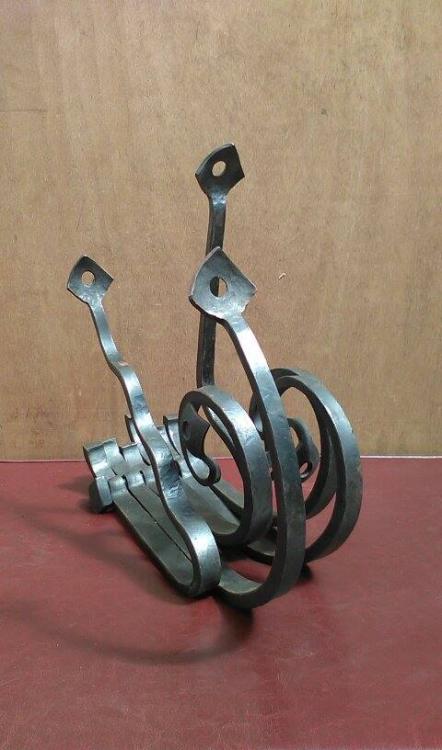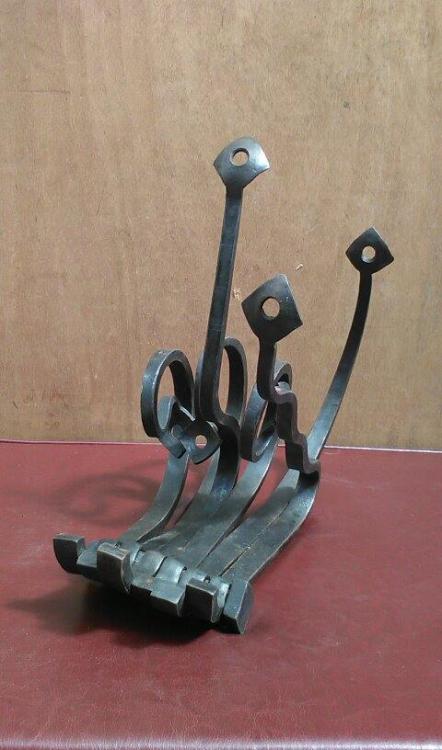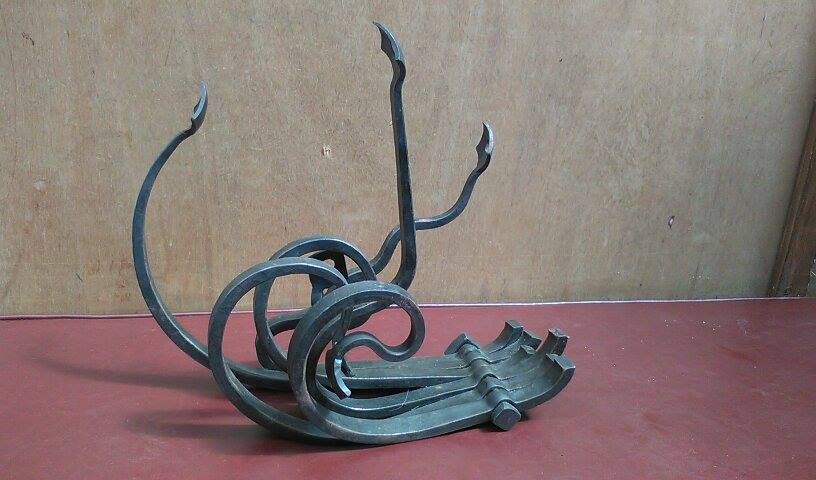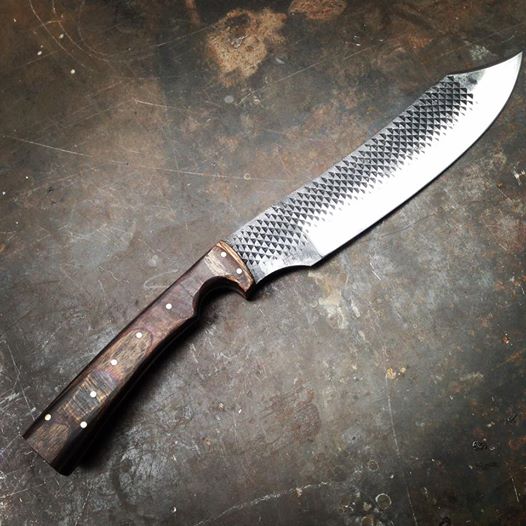-
Posts
106 -
Joined
-
Last visited
Content Type
Profiles
Forums
Articles
Gallery
Downloads
Events
Everything posted by forging-fool
-
Thanks. I used JAX patina, you can get it on ebay.
-
This is my latest sculpture, it is called The Roses and was inspired by the White Rose movement of Munich. The panels are made up of copper plate and mild steel and they are 1m or 40" tall, all completely riveted together.
-
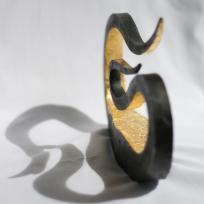
Not Dying. A short film
forging-fool replied to forging-fool's topic in Blacksmithing, General Discussion
Thank you, I appreciate the feed back.- 16 replies
-

Not Dying. A short film
forging-fool replied to forging-fool's topic in Blacksmithing, General Discussion
- 16 replies
-

Not Dying. A short film
forging-fool replied to forging-fool's topic in Blacksmithing, General Discussion
Thanks Frosty.- 16 replies
-

Show Me Your Candle Holders
forging-fool replied to Forging Carver's topic in Blacksmithing, General Discussion
Thanks guys. -

Not Dying. A short film
forging-fool replied to forging-fool's topic in Blacksmithing, General Discussion
Thanks fellas. Unfortunately I did not get to photograph it before it found a new owner. I've been meaning to go get photos of it, as soon as I do I'll post them.- 16 replies
-

Show Me Your Candle Holders
forging-fool replied to Forging Carver's topic in Blacksmithing, General Discussion
Thank you. -
This is a short film I made some time ago in collaboration with a young film maker Simon Watson. We filmed it over two days, making a sculpture from start to finish. The sculpture was not pre-designed, it was an Idea I had been think about for maybe a week. A lot of the time with sculpture I like to work from my head instead of drawings, it feels more natural that way. Hope you enjoy it.
- 16 replies
-

Wrought iron style headboard
forging-fool replied to Eisenreich's topic in Blacksmithing, General Discussion
So Thomas is mild steel and stainless steel styles? -

Wrought iron style headboard
forging-fool replied to Eisenreich's topic in Blacksmithing, General Discussion
You are right, just looked at my photo's from the last time I was there back in 2007, thay are pass-throughs not collars. I stand corrected. But that dose not mean collars and unreliable. Wrought iron is a martial not a style. That's like saying the 60's was style. It has come to loosley mean traditional Georgian style forge work but it is still a misunderstanding of the term. -

Wrought iron style headboard
forging-fool replied to Eisenreich's topic in Blacksmithing, General Discussion
I too live in the real world. I still have the first thing I made with forged collars, in fact I learnt to make them on that project and they have never budged. The largest protect I made using them was an arch, 12ft tall and 16ft wide, it is held together completely with collars and never moved. None of the collars I've made over my carrier have ever failed. The first ever Iron bridge in England is partly held together with collars. Johnathan may not be experienced, but he can learn. I've learnt most of my skills by putting it into customers work, it's a great motivator to getting it right. To be honest I've had people tell me traditional forged joinery was not reliable all my carrier but the proof is not just in my work it's in the multitude of fully forged work still doing it's job. Now I'm not telling Johnathan what he should do, if he wants to weld then collar that is his chose and is as lagitimate as not welding. But it's just not true to suggest collars are not safe, the evidence far out ways that view. -
Forged, I don't have a good enough belt grinder to do stock removal and I'm old school a bit, prefer forging it.
-

Wrought iron style headboard
forging-fool replied to Eisenreich's topic in Blacksmithing, General Discussion
Why do you feel the need to reinforce the welds? -

Wrought iron style headboard
forging-fool replied to Eisenreich's topic in Blacksmithing, General Discussion
In general rivets and collars do not need to be reinforced with welds, they are a proven method of joinery in steel and iron for thousands of years. I only use traditional joinery in all my work and have never had a failed joint. I don't know exactly what you mean by wrought iron style, but most customers that say that to me want scroll work, so I'll assume that's what you are talking about. The biggest tip on repeated scroll work is to get jigs made first. You can find plenty of how to advice on scroll jigs. It's amazing how with only three sizes of scroll you can fill huge panels, but if you want it to pop they need to be uniformed, which is what the jigs will do for you. For future reference wrought Iron is a material not a style. It's a common misconstruction but very important to blacksmith history. (Not trying to be preachy here, just informative) -

Show Me Your Candle Holders
forging-fool replied to Forging Carver's topic in Blacksmithing, General Discussion
This candelabra is almost 2m tall, I made it using 50mm x 8mm strap and 25mm square bar. It is held together with only four rivets 12mm, I wanted to see how simply I could join a large object together. -
The local Farriers popped into my forge last week and dropped of some of their old rasps. So what do you do when the world gives you blunt rasps? You make upcycle knifes of course. Overall length is 400mm or 16" in old money. Decided to keep the up-cycling theme going for the handle and used some old marine ply I had lying under the bench. I have to say this was a fun distraction for my usual work.
-
Thank you.
-
I would imagine it would be. But you would lose the benefit of being able to quick change the tooling I'd guess.
-
Thank you. They are 20", there's no flex. I'd imagine you would be using them all the time in a sheetmetal shop.
-
I find if you make the the section for the hardy hole longer, then bend it back on it's self but at a 90 degree to the first bend. You have enough mass to forgeweld it and forge it down to a snug fit for your hardy hole. Gives you a more stable tool.
-
The hinge way hot cut. I find I get more precision with the hot cut rather than a fireweld. I hand forged it right down to a fine finish then used the hand file on hot metal to get the finish. Thanks. I can't remember where I saw this done first but I copied the idea from somewhere.
-
Yes epoxy was the best way to go with this project. The steps are made of unstable material, not stone, so I knew epoxy would help stabilize any problem areas. The punching and drifting weren't the problem with this. It was getting everything to flow that took the time. You cant really see in the photos but none of the steps are the same height or depth. So none of the arcs are repeats, they each had to be different so as to create the illusion of formality.
- 17 replies
-
- Hand forged
- Ballnuts
-
(and 5 more)
Tagged with:
-
I feel 30" is enough.
-
There are slimier laws here. 1.1m is the minimum handrail height, which this is. As for 100mm passage, it is for the the customer to decide, as long as they are aware of the guidelines and the work is not open to public access. As this is private property well away from the public road there is no issue. Most of these codes in Ireland and the UK are actually guidelines that are taken as law by planing officers. It is discretionary to allow them if it is in keeping with the style of the architecture. Otherwise you'd never be able to create reconstruction of original ironwork for say an extension to a 18th century building.
- 17 replies
-
- Hand forged
- Ballnuts
-
(and 5 more)
Tagged with:

